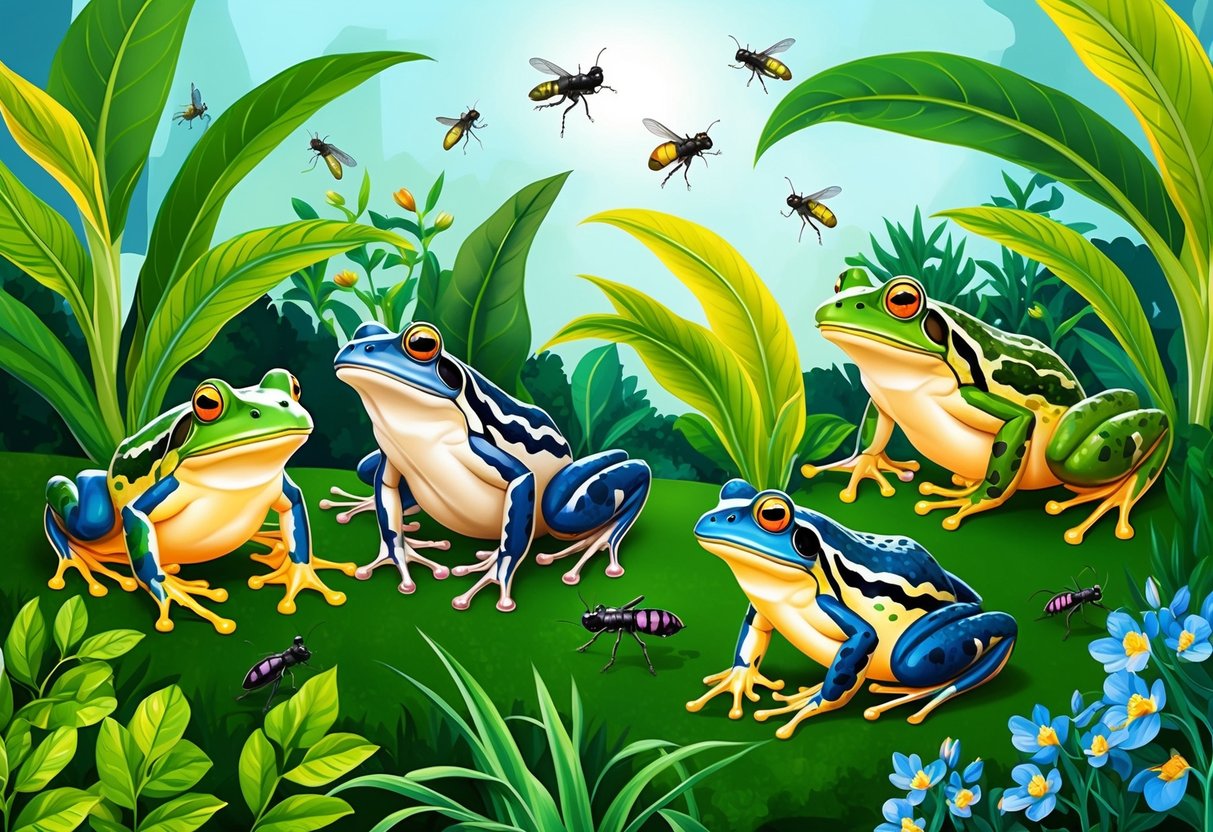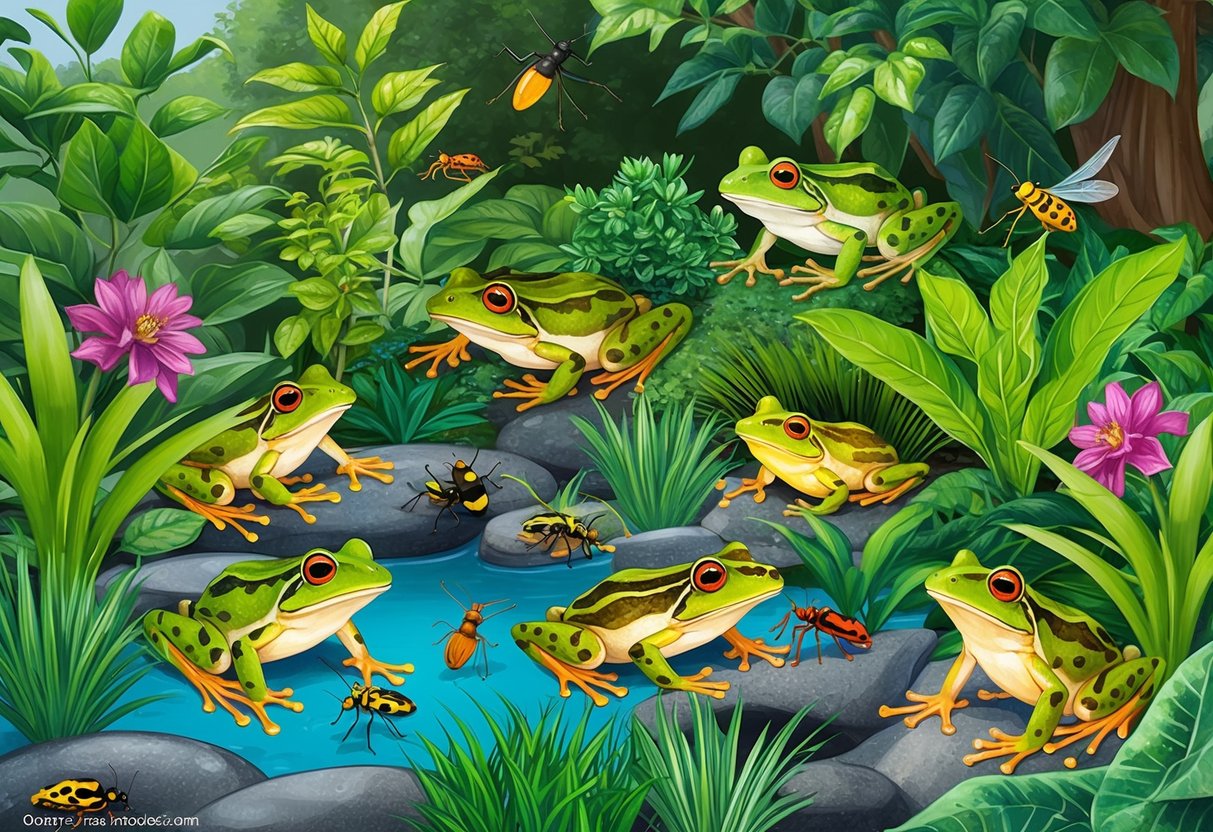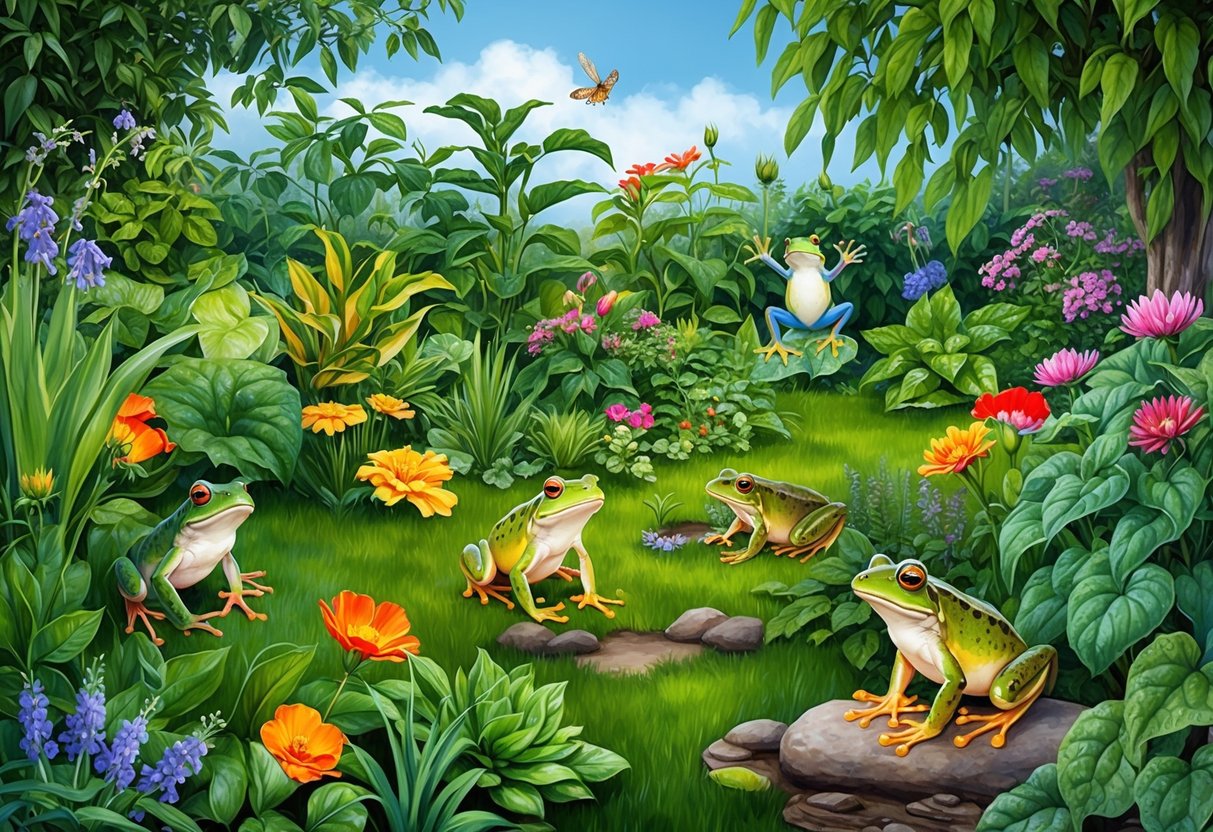The Benefits Of Having Frogs In Your Garden Ecosystem: Nature’s Little Helpers
Frogs are amazing little creatures that can make a big difference in your garden. These small amphibians bring many benefits to your outdoor space.
Having frogs in your garden can help control pests naturally, improve soil health, and boost biodiversity.

Frogs eat lots of bugs that can harm your plants. They munch on mosquitoes, slugs, and other pests that might damage your flowers and veggies.
By keeping these pests in check, frogs help your garden thrive without using chemicals.
A frog-friendly garden is often a sign of a healthy ecosystem. Frogs are sensitive to environmental changes, so their presence means your garden is doing well. Plus, watching and listening to frogs can be fun and educational for the whole family.
Key Takeaways
- Frogs eat garden pests and help control insect populations
- A frog-friendly garden shows a healthy, balanced ecosystem
- Frogs provide natural pest control without harmful chemicals
Why Frogs Are Essential for Gardens
Frogs play a vital role in keeping your garden healthy and thriving. These small amphibians offer natural pest control, act as environmental indicators, and even help with plant pollination.
Natural Pest Control
Frogs are excellent at controlling pests in your garden. They have a big appetite for insects that can damage your plants. A single frog can eat over 100 insects in one night!
Frogs love to munch on:
- Mosquitoes
- Flies
- Cockroaches
- Caterpillars
- Beetles
- Slugs
By eating these pests, frogs help protect your plants from damage. This means you might not need to use harmful chemicals or pesticides in your garden.
Frogs use their long, sticky tongues to catch flying insects mid-air. This skill makes them super effective at keeping bug populations in check.
Bioindicators of Ecosystem Health
Frogs are sensitive to changes in their environment. This makes them great indicators of your garden’s overall health.
Frogs breathe through their skin, which is thin and permeable. This means they quickly absorb toxins from water, air, and soil.
If you see lots of frogs in your garden, it’s a good sign that your ecosystem is balanced and healthy.
On the flip side, if frogs start disappearing from your garden, it could mean:
- Water pollution
- Soil contamination
- Air quality issues
By paying attention to frog populations, you can spot problems in your garden early. This gives you a chance to fix issues before they become serious.
Plant Pollination Support
While not as well-known as bees or butterflies, some frogs actually help pollinate plants in your garden.
Tree frogs, for example, can transfer pollen as they hop from flower to flower. This is especially helpful for plants that bloom at night when many other pollinators are inactive.
Frogs also indirectly support pollination by eating insects that might harm pollinators. By keeping pest populations down, frogs help create a safer environment for bees and butterflies to do their important work.
Creating a Frog-Friendly Garden
Turning your garden into a frog haven is easier than you might think. With a few simple changes, you can create an inviting space that frogs will love to call home.
Providing Shelter
Frogs need safe spots to hide and rest. You can make your garden more frog-friendly by adding:
- Log piles
- Rock piles
- Leaf litter
- Overturned flowerpots
Place these shelters near water sources. Frogs like to stay close to moisture.
Leave some areas of your garden a bit wild and untidy. This gives frogs more places to hide.
Consider adding a small frog house. You can buy these or make your own from wood or clay pots. Put them in shady spots near plants or water.
Maintaining Moisture
Frogs need water to survive. They absorb it through their skin.
Create a small pond in your garden to give frogs a perfect home. Even a shallow dish of water can help.
Keep your pond chemical-free. Use native water plants to keep it clean. Add some rocks or logs for frogs to rest on.
Mist your garden regularly, especially in dry weather. This keeps the area moist and frog-friendly. You can also use a drip irrigation system to maintain moisture.
Choosing the Right Plants
Pick plants that frogs love. Native plants are best. They attract insects that frogs eat. Some good choices are:
- Ferns
- Hostas
- Mosses
- Native grasses
Plant in layers. This creates different levels for frogs to explore. Ground cover plants give frogs places to hide. Taller plants provide shade and shelter.
Include a mix of shrubs and trees to create a diverse habitat. This attracts more insects and gives frogs more options for shelter.
Avoiding Chemicals
Frogs have sensitive skin, so chemicals can harm them. Avoid using pesticides, herbicides, and chemical fertilizers in your garden. These can poison frogs or kill their food sources.
Try natural pest control methods instead:
- Companion planting
- Handpicking pests
- Using barriers like copper tape
Use organic fertilizers like compost or well-rotted manure. These are safer for frogs and other wildlife. They also improve soil health.
Be careful with slug pellets. Many are toxic to frogs. Try beer traps or eggshell barriers instead. Remember, frogs eat slugs and can help control them naturally.
Frogs’ Role in Soil Improvement
Frogs contribute to soil health in your garden through their daily activities. Their presence can enhance soil quality and promote plant growth in surprising ways.
Fertilization through Droppings
Frog droppings add valuable nutrients to your garden soil. Their poop is rich in nitrogen, phosphorus, and potassium – key elements plants need to thrive.
These natural fertilizers help nourish your plants without the need for chemical additives.
Frog waste also contains organic matter that improves soil structure. This helps your soil retain moisture and nutrients better. As a result, your plants can access water and food more easily.
The small size of frog droppings allows them to break down quickly. This means nutrients become available to plants faster than larger animal waste.
Aeration Through Movement
As frogs hop and burrow in your garden, they naturally aerate the soil. This movement creates tiny air pockets in the ground, which are crucial for healthy root growth.
Well-aerated soil allows roots to spread more easily and access oxygen.
Frog activity also helps water penetrate deeper into the soil. This reduces runoff and ensures your plants get the moisture they need. The small tunnels frogs create can act as drainage channels, preventing waterlogging in heavy soils.
Their burrowing can bring deeper soil layers to the surface. This mixing action helps distribute nutrients more evenly throughout your garden bed.
Enhancing Biodiversity with Frogs
Frogs play a key role in boosting the variety of life in your garden. They help create a rich ecosystem by supporting food webs and drawing in other helpful creatures.
Supporting a Balanced Food Web
Frogs are both predators and prey, making them vital for a healthy garden food web. They eat various insects like mosquitoes, flies, and beetles. This helps keep pest populations in check naturally.
As tadpoles, frogs feed on algae and plant matter. This keeps your garden pond clean and balanced. Adult frogs then become food for birds, snakes, and other animals.
By adding frogs to your garden, you create more links in the food chain. This leads to a more stable and diverse ecosystem. A balanced food web means fewer pest outbreaks and a healthier garden overall.
Attracting Beneficial Wildlife
Frogs act like magnets for other helpful garden visitors. Their presence can draw in a wide range of creatures that benefit your garden.
Birds often come looking for frogs as a food source. These birds may then stick around to eat garden pests too. Dragonflies and other insects are also attracted to frog-friendly areas.
The moist environments frogs need can attract beneficial insects like ladybugs and ground beetles. These insects help control garden pests naturally.
By making your garden frog-friendly, you create a mini nature reserve. This rich habitat supports a wide variety of life, making your garden more interesting and lively.
Educational and Enjoyment Value

Frogs bring fun and learning to your garden. They offer chances to watch nature up close and spark interest in gardening for kids and adults alike.
Observing Frog Behavior
Frogs are fascinating creatures to watch. You can see them catch insects with their long tongues or hear them croak at night.
Set up a small pond or water feature to attract frogs.
Watch how they change through their life cycle. Tadpoles grow legs and lose their tails as they turn into frogs. This gives you a front-row seat to see metamorphosis happen.
Keep a nature journal to note when frogs appear each year. Track their sounds and behaviors in different seasons. This helps you learn about local wildlife patterns.
Inspiring Young Gardeners
Frogs can get kids excited about nature and gardening. Let children help create frog-friendly spaces with plants and hiding spots. This teaches them about animal habitats.
Have a frog-spotting contest to see who can find the most frogs. Kids will love searching for these hoppy friends. It gets them outside and moving.
Use frogs to teach about the food chain. Show how frogs eat bugs and how birds might eat frogs. This helps explain how all parts of your garden work together.
Relaxation and Well-Being
The soft croaking of frogs can be very calming. Sit outside on a summer evening and listen to their chorus. It’s a natural form of stress relief.
Watching frogs can lower your blood pressure. Take a few minutes each day to observe them. It’s a simple way to practice mindfulness in your garden.
Knowing frogs are in your garden means it’s healthy. This can make you feel good about your gardening efforts. You’ve created a space that supports wildlife.
Conservation Efforts in Your Backyard
You can play a big role in frog conservation right in your own garden. By creating a frog-friendly space, you’re helping these amazing creatures thrive.
Start by adding a small pond or water feature. Frogs need water to breed and stay hydrated. Make sure it has shallow edges for easy access.
Plant native vegetation around your pond. This gives frogs places to hide and hunt. Choose plants that don’t need pesticides, as chemicals can harm frogs.
Leave some areas of your garden wild. Tall grass, leaf litter, and logs provide shelter for frogs. These spots also attract insects for frogs to eat.
Avoid using chemical pesticides and fertilizers. These can be toxic to frogs and their food sources. Try natural pest control methods instead.
Provide hiding spots like upturned flowerpots or specially designed frog houses. This gives frogs safe places to rest during the day.
Keep cats indoors or supervised when outside. Cats can be a major threat to frogs and other wildlife in your garden.
By taking these steps, you’re creating a safe haven for frogs. Your efforts help support local frog populations and the wider ecosystem they’re part of.
Frequently Asked Questions

Frogs offer many benefits to gardens. They help control pests, improve plant health, and support biodiversity. Let’s explore some common questions about how frogs contribute to garden ecosystems.
What are the positive impacts of frogs on plant health in gardens?
Frogs help plants grow better. They eat bugs that might harm your vegetables and flowers. This natural pest control means you don’t need to use as many chemicals in your garden.
Frogs also make the soil healthier. Their waste adds nutrients that plants can use to grow stronger.
How can frogs contribute to a balanced garden ecosystem?
Frogs play a key role in your garden’s food web. They eat insects and small animals, while also being food for birds and other creatures. This helps keep the ecosystem balanced.
Their presence shows your garden is healthy. It means there’s enough food and shelter for different kinds of animals to live there.
What advantages do frogs offer in pest control within gardens?
Frogs are great at catching pests. They eat mosquitoes, flies, slugs, and other bugs that can damage your plants. Their long tongues help them catch even flying insects.
You might not need to use chemical pesticides if you have frogs. This is better for your plants and other helpful garden creatures.
In what ways are frogs beneficial to maintaining garden biodiversity?
Frogs attract other animals to your garden. Birds, snakes, and small mammals might come to eat the frogs. This creates a diverse ecosystem in your yard.
Some frogs, like tree frogs, can even help pollinate plants. This adds to the variety of life in your garden.
Why might frogs appear in gardens without ponds, and is this beneficial?
Frogs can live in gardens without ponds if there’s enough moisture. They like damp, shady spots under leaves or in tall grass.
Having frogs even without a pond is good. It means your garden has places for them to hide and find food.
How do the environmental benefits of frogs extend beyond the garden?
Frogs help the environment outside your garden too. They eat mosquitoes, which can spread diseases to humans and pets.
Frogs are also indicators of environmental health. If frogs are doing well in your area, it often means the local ecosystem is healthy.
